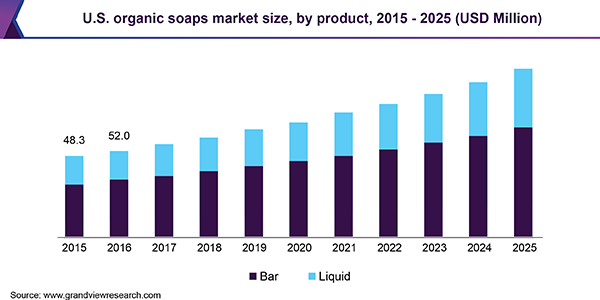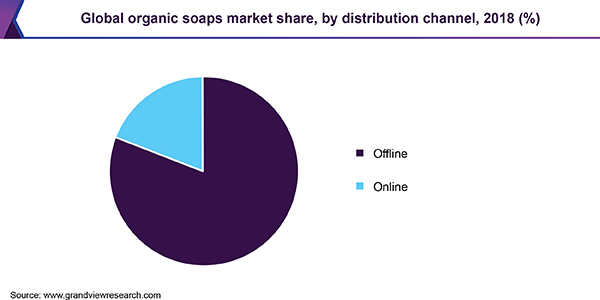- Home
- »
- Beauty & Personal Care
- »
-
Global Organic Soaps Market Size, Industry Trends Report, 2019-2025GVR Report cover
![Organic Soaps Market Size, Share & Trends Report]()
Organic Soaps Market Size, Share & Trends Analysis Report By Product (Bar, Liquid), By Distribution Channel (Offline, Online), By Region, Competitive Landscape, And Segment Forecasts, 2019 - 2025
- Report ID: GVR-3-68038-455-0
- Number of Pages: 80
- Format: Electronic (PDF)
- Historical Range: 2015 - 2017
- Industry: Consumer Goods
Industry Insights
The global organic soaps market size was valued at USD 222.3 million in 2018. Growing focus on skincare and hygiene, coupled with rising awareness about the harmful side effects of chemical and synthetic ingredients in personal care products, including soaps, is expected to be a key driver for the market. Moreover, increasing consciousness regarding environment conservation and growing water pollution caused by harmful chemicals present in personal care products will open new growth avenues for the overall organic product category over the forecast period.
Consumer awareness regarding synthetic chemicals present in toiletries like hand and bathing soaps has been at an all-time high in recent years. As a result, over the past few years, governments of several countries have been banning harmful chemicals used in cosmetics and personal care products, such as parabens, triclosan, phthalates, triclocarban, and aluminum salts, to promote organic, herbal, and all-natural soaps.

For instance, in April 2017, the European Commission banned Octamethylcyclotetrasiloxane (D4) and Decamethylcyclopentasiloxane (D5) in concentrations above 0.1% from all kinds of leave on personal care products, cosmetics, and other consumer or professional care products, including washing products, waxes, polishes, and dry cleaning products. In February 2019, the EU also banned dodecamethylcyclohexasiloxane (D6) in concentrations above 0.1% from all wash-off cosmetic products, including hand soaps.
Consumer preference for organic ingredients in personal care products is supported by the efforts of various certification bodies such as The International Natural and Organic Cosmetics Association (NATRUE). The association mandated that at least 95.0% of physically processed agro-ingredients in rinse-off products such as soaps and shampoo must be organic.
Product Insights
Based on the product, organic bar soaps dominated the industry, accounting for more than 70.0% of the global revenue in 2018. Low price and easy product availability in offline, brick-and-mortar stores are expected to remain the favorable factors for segment growth over the next few years. Additionally, industry participants have been increasing their spending on launching innovative products with attractive packaging, unique shapes and sizes, and more informative label information to attract customers.
The liquid segment is expected to register the highest CAGR of 8.4% in the organic soaps market from 2019 to 2025. Liquid soaps are preferred by consumers over bar soaps as they are more hygienic. Customers are becoming more aware regarding family bathing products and are offering a host of organic and natural personal care products. Key manufacturers such as SUNDIAL BRANDS LLC; Lush Retail Ltd.; Osmia Organics, LLC; EO Products; Pangea Organics, Inc.; and Brittanies Thyme are launching new products to cater to increasing product demand. For instance, in April 2019, Korkut Oil Soap Industries Inc. introduced a liquid soap made from unique ingredients: goat milk and extra virgin olive oil. The product, called ‘Olivos Goat Milk Liquid Soap’, helps delay signs of aging and removes dead skin.
Distribution Channel Insights
The offline distribution channel emerged as the dominant segment in 2018, accounting for more than 80.0% of the market revenue. Consumers prefer to buy personal care products, including organic soaps, from supermarkets, hypermarkets, and other retail outlets as they allow physical verification before any purchases. Also, the availability of various brands under a single platform makes it convenient for buyers. Expansion of middle-income groups in developing economies like China, Bangladesh, Pakistan, and India is expected to compel supermarkets to establish new outlets on a domestic level.

Revenue generated from online channels is expected to increase at the fastest pace over the forecast period, registering a CAGR of 8.5% from 2019 to 2025. Manufacturers are ensuring the availability of their organic products on online portals, which increases product visibility and also allows customers to purchase them even from remote locations. Online distribution channels also serve as a good platform for new entrants to the industry as they can promote and sell their products across the globe without getting involved with distribution channel partners such as dealers and distributors.
Regional Insights
North America is the dominant market for organic soaps and accounted for more than 30.0% of the global revenue in 2018. The high concentration of U.S.-based companies such as Pangea Organics, Inc.; Osmia Organics, LLC; EO Products; and Brittanies Thyme is expected to ensure continuous product supply to consumers over the next few years. Key manufacturers are adopting strategies like product launches, expansion of distribution chains, mergers, and acquisitions to gain a stronghold in the market. For instance, in July 2017, Canada-based Rocky Mountain Soap Company Inc. announced its plans to extend its retail chain with the addition of 10 more retail stores in western Canada.
Europe is expected to emerge as the fastest-growing market throughout the forecast period, registering a CAGR of 8.7% from 2019 to 2025. Manufacturers are launching new products that are organic, herbal, cruelty-free, and chemical-free to cater to evolving customer demands.
Organic Soaps Market Share Insights
The market for organic soaps is fragmented in nature owing to the presence of a large number of players such as SUNDIAL BRANDS LLC, Lush Retail Ltd., Osmia Organics, LLC, EO Products, and Beauty & the Bees. Industry participants are utilizing extensive media campaigns and partnering with retail channels to expand their reach and customer base for organic soaps. For instance, in November 2018, Lush Retail Ltd., a-U.K.-based natural personal care products manufacturer launched a one-of-its-kind concept retail store in Tokyo. Dedicated to the brand’s star product, the bath bomb, the store sells the products without any labels or packaging. For product information and demonstration, customers can view the same on the company’s ‘LushLab’ mobile app, which scans the product and provides all the information they might need systematically.
Key manufacturers are improving their product visibility on a global level through the launch of various retail chains, especially in developed countries such as Germany, France, Italy, and the U.K. Moreover, companies have been receiving funding from investor companies to expand their inventory of organic products. These marketing strategies are anticipated to open new avenues over the foreseeable future.
Report Scope
Attribute
Details
The base year for estimation
2018
Actual estimates/Historical data
2015 - 2017
Forecast period
2019 - 2025
Market representation
Revenue in USD Million & CAGR from 2019 to 2025
Regional scope
North America, Europe, Asia Pacific, Central & South America, Middle East & Africa
Report coverage
U.S., U.K., Germany, France, China, Japan, India, Brazil
Country Scope
Revenue forecast, company share, competitive landscape, growth factors and trends
15% free customization scope (equivalent to 5 analyst working days)
If you need specific information, which is not currently within the scope of the report, we will provide it to you as a part of customization
Segments Covered in the ReportThis report forecasts revenue growth at global, regional, and country levels and provides an analysis of the latest industry trends in each of the sub-segments from 2015 to 2025. For this study, Grand View Research has segmented the global organic soaps market report based on the product, distribution channel, and region:
-
Product Outlook (Revenue, USD Million, 2015 - 2025)
-
Bar
-
Liquid
-
-
Distribution Channel Outlook (Revenue, USD Million, 2015 - 2025)
-
Online
-
Offline
-
-
Regional Outlook (Revenue, USD Million, 2015 - 2025)
-
North America
-
The U.S.
-
-
Europe
-
U.K.
-
Germany
-
France
-
-
Asia Pacific
-
China
-
India
-
-
Central & South America
-
Brazil
-
-
Middle East & Africa
-
Share this report with your colleague or friend.
![gvr icn]()
NEED A CUSTOM REPORT?
We can customize every report - free of charge - including purchasing stand-alone sections or country-level reports, as well as offer affordable discounts for start-ups & universities. Contact us now
![Certified Icon]()
We are GDPR and CCPA compliant! Your transaction & personal information is safe and secure. For more details, please read our privacy policy.
We are committed towards customer satisfaction, and quality service.
"The quality of research they have done for us has been excellent."





